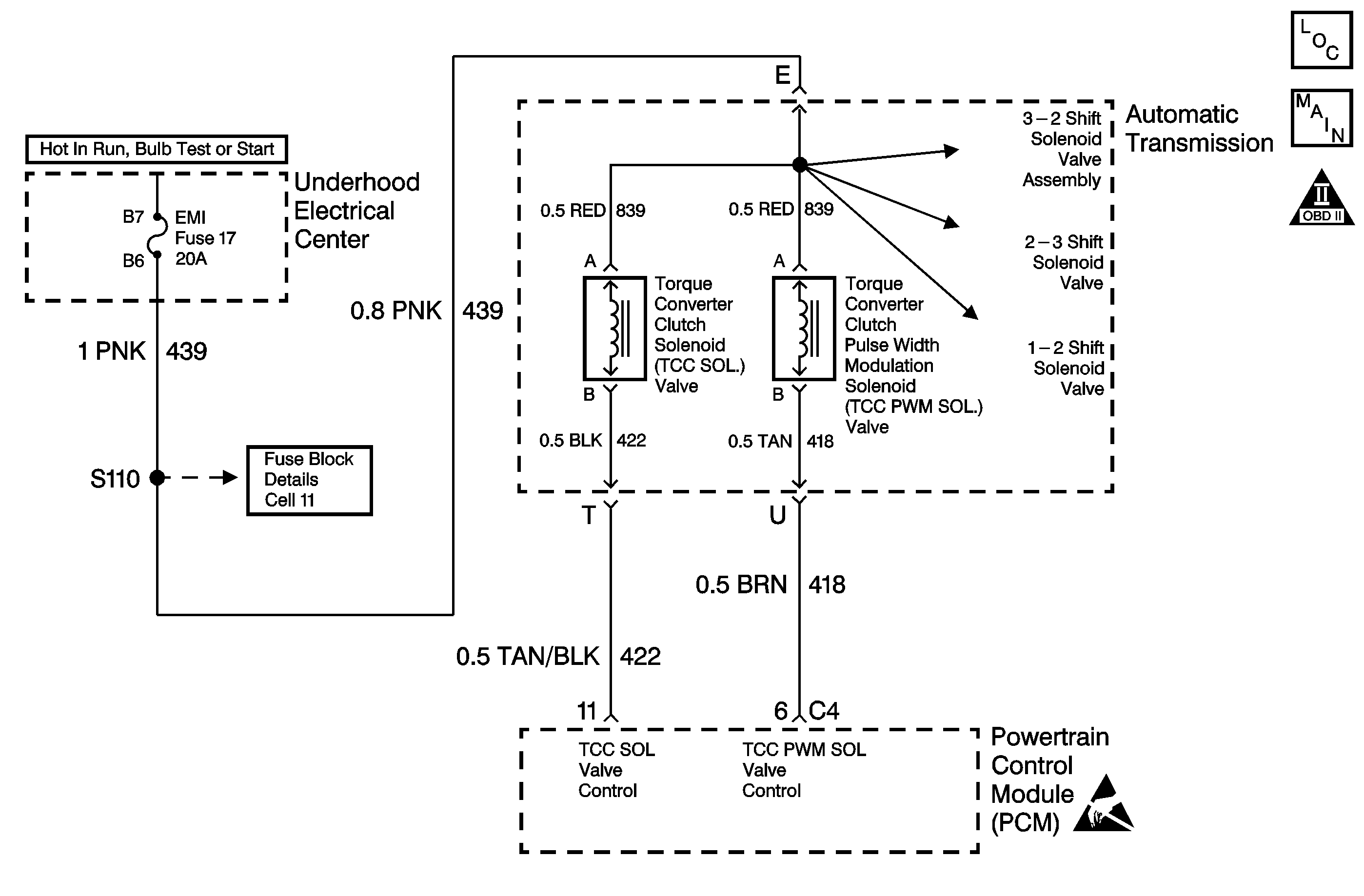
Circuit Description
The TCC PWM Solenoid Valve controls the fluid acting on the converter clutch valve, which then controls the application and release of the TCC. The solenoid attaches to the control valve body within the transmission. Circuit 439 supplies ignition voltage directly to the solenoid. The PCM controls the solenoid by providing a ground path on circuit 418. Current flows through the solenoid coil according to the duty cycle (percentage of ON and OFF time). The TCC PWM Solenoid Valve provides a smooth engagement of the torque converter clutch by operating during a duty cycle percent of ON time.
If the PCM detects a continuous open or a short to ground in the TCC PWM circuit or the TCC PWM Solenoid Valve, then DTC P1860 sets. DTC P1860 is a type A DTC.
Conditions for Setting the DTC
| • | The system voltage is 10-17 volts. |
| • | No 2-3 shift solenoid valve DTCs P0756 or P0758. |
| • | No 1-2 shift solenoid valve DTCs P0751 or P0753. |
| • | The ignition is ON. |
| • | First gear commanded. |
| • | The PCM commands the solenoid to 0% and the voltage remains high (Battery Positive Voltage). |
| • | All conditions are met for 5 seconds. |
Runs only during intrusive test:
| • | The TCC is at 100% duty cycle for greater than 0.1 second. |
| • | The TCC is at 0% duty cycle for greater than 5 seconds. |
| • | Once per key cycle |
Action Taken When the DTC Sets
| • | The PCM inhibits TCC engagement. |
| • | The PCM inhibits 4th gear if in hot mode. |
| • | The PCM freezes shift adapts from being updated. |
| • | The PCM commands maximum line pressure. |
| • | The PCM illuminates the Malfunction Indicator Lamp (MIL). |
Conditions for Clearing the MIL/DTC
| • | The PCM turns OFF the MIL after three consecutive ignition cycles without a failure reported. |
| • | A scan tool can clear the DTC from the PCM history. The PCM clears the DTC from the PCM history if the vehicle completes 40 warm-up cycles without a failure reported. |
| • | The PCM cancels the DTC default actions when the fault no longer exists and the ignition is OFF long enough in order to power down the PCM. |
Diagnostic Aids
| • | Inspect the wiring for any poor electrical connections at the PCM. Inspect the wiring at the transmission 20-way connector. Look for the following conditions: |
| - | A bent terminal |
| - | A backed out terminal |
| - | A damaged terminal |
| - | Poor terminal tension |
| - | A chafed wire |
| - | A broken wire inside the insulation |
| • | When diagnosing for an intermittent short or an open condition, massage the wiring harness while watching the test equipment for a change. |
Test Description
The numbers below refer to the step numbers on the diagnostic table.
-
This step verifies that the solenoid receives current.
-
This step verifies the ability of the PCM and the wiring to control the ground circuit.
-
This step measures the resistance of the TCC PWM Sol. Valve and the Automatic Transmission wiring harness.
Step | Action | Value(s) | Yes | No | ||||||||
|---|---|---|---|---|---|---|---|---|---|---|---|---|
1 | Was the Powertrain On-Board Diagnostic (OBD) System Check performed? | -- | Go to Powertrain On Board Diagnostic (OBD) System Check , Section 6. | |||||||||
2 |
Important: Before clearing the DTCs, use the scan tool in order to record the Freeze Frame and the Failure Records for reference. The Clear Info function will erase the data. Are DTCs P0753, P0758, P1860, P1864, or P1886 set? | -- | ||||||||||
3 | Inspect the following components for an open or a short to ground.
Refer to Electrical Diagnosis, Section 8. Did you find and correct a problem? | -- | -- | |||||||||
Does the test lamp illuminate? | -- | |||||||||||
5 | Repair the open or short to ground in the ignition feed circuit 439 (PNK) to the TCC PWM Solenoid Valve. Refer to Electrical Diagnosis, Section 8. Is the repair complete? | -- | -- | |||||||||
Does the test lamp illuminate when you command the TCC PWM Solenoid Valve ON, and turn OFF when you command the valve OFF? | -- | |||||||||||
7 |
Refer to Electrical Diagnosis, Section 8. Did you find and correct a problem? | -- | ||||||||||
Is the resistance within the specified range? | 10-15ohms | |||||||||||
9 |
Did you find and correct a problem? | -- | ||||||||||
10 |
Is the resistance within the specified range? | 10-15ohms | ||||||||||
11 |
Are both readings greater than the specified value? | 250ohms | Go to Diagnostic Aids | |||||||||
12 |
Refer to Electrical Diagnosis, Section 8. Did you find and repair a problem? | -- | -- | |||||||||
13 |
Are both readings greater than the specified value? | 250ohms | ||||||||||
14 |
Refer to Electrical Diagnosis, Section 8. Did you find and correct a problem? | -- | -- | |||||||||
15 | Replace the TCC PWM Solenoid Valve. Refer to Control Valve Body and Pressure Switch, in On-Vehicle Service. Is the replacement complete? | -- | -- | |||||||||
16 | Replace the PCM. Refer to Powertrain Control Module Replacement/Programming , Section 6. Is the replacement complete? | -- | -- | |||||||||
17 |
Has the test run and passed? | -- | System OK |
